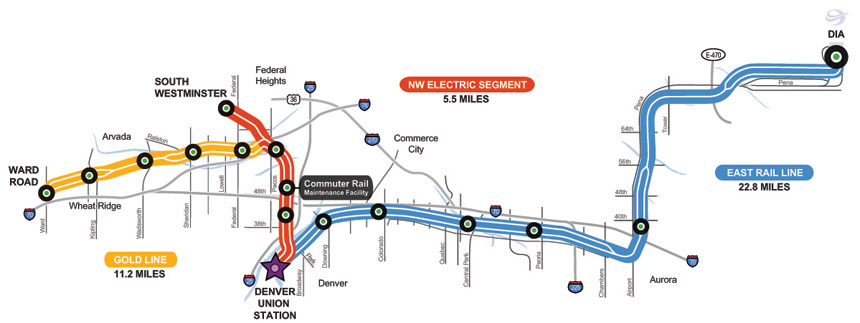
Denver Eagle P3: An Exploration of the Innovative DBFOM Public/Private Partnership Model
The Denver Eagle P3 is a transit project in Denver Colorado involving the Regional Transportation District (RTD) and a private group of developers, the Denver Transit Partners. The project is part of the RTD FasTracks public transportation expansion plan. What makes this project so unique is the type of public private partnership in which the project is structured. The Denver Transit partners is responsible for the designing, building, partially financing, operating and maintaining of two commuter rail lines. The DBFOM structure is a novelty in the US and this project is the first one to successfully deploy such a model.
The Denver Transit Partners is a consortium led by Fluor Corporation and Macquarie Group, along with Uberior Infrastructure Investments and Balfour Beatty as the other major partners. RTD created a competitive process to select a private sector group to pursue the project. The process began in August 2008, when the RTD issued a request for qualifications, to which three companies responded. In September 2009, a request for proposal was sent to each company out of which, RTD received two technical proposals followed by two final proposals in May of 2010. In June, the RTD awarded project to Denver Transit Partners and the project was a go.
The project cost roughly $2.2 billion to build, consisting largely of three funding sources: federal grants and loans, local government funds, and private partner direct contributions.
The funding breakdown was as follows:
Denver Transit Partners will contribute $450 million, $396 of which will come from proceeds of Private Activity Bonds and $54 million of which will come from cash equity.
A federal grant of $1.03 billion, and a federal loan of $280 million,
- Local RTD bond proceeds and sales tax revenues, plus local government matching funds, cover the remainder.
It is estimated that the involvement of a private sector company saved about $300 million in construction costs compared to estimates of the cost if the RTD were solely responsible for the project.
Three New Lines

Denver Transit Partners was responsible for development of the following portions of the FasTracks system:
- East Corridor – a new 22.8-mile commuter rail line from Denver International Airport to Denver Union Station
- Gold Line – a new 11.2-mile commuter rail line from Union Station to Wheat Ridge, Colorado
- An initial 2-mile segment of the Northwest Electrified Rail Corridor
- Approximately 50 new electric-powered commuter railcars
- A new commuter rail maintenance facility
- Provision and integration of rolling stock, infrastructure elements (track, stations, structures and railway / road crossings), and system elements (traction power, power supply, automated train control/positive train control, signaling, communications, and SCADA systems)
- Operations and maintenance of the three rail lines

Eagle P3 was completed in two phases. Phase One included the construction of the East Corridor and the section of the Northwest Corridor included in Eagle P3, as well as the new operations and maintenance facility. Also undertaken during phase 1 was the design work for the Gold Corridor and the remaining part of the Northwest Corridor, the purchase of rolling stock and the electrification of trackage into Denver Union Station.
The second phase of the project is the construction of the Gold and Northwest Corridors that were designed during Phase One. Construction of the East Corridor began in August 2010 and the groundbreaking for the Gold Corridor took place in August 2011. The University of Colorado A Line of the Denver Eagle P3 Commuter Rail opened to the general public on April 22, 2016. The B Line opened later that year in July.
DBFOM
Design-Build-Finance-Operate-Maintain

The DBFOM delivery mechanism is used globally by government entities to structure the construction of public infrastructure projects such as roads, bridges and airports. In this structure, the government entity enters into an agreement with a private sector party where it allocates all of the project's duties to that party. This includes designing, constructing, financing, operating and maintaining the project. In exchange for assuming these obligations, the private sector party is entitled to receive fees from the end users of the project or payments directly from the government for a specified period of time. At the end of the period, operating control is transferred back to the government entity. This structure is preferred by many governmental entities because:
- It allocates most of the risks of the project to the private sector.
- They are able to construct a project for which they may not have the financial, technical or operational capacity.
- Project can generally be built for less than if the process was managed by the transit agency.
The Eagle P3 was structured as a 34-year design-build-finance-operate-maintain (DBFOM) concession contract. RTD will make monthly availability payments to Denver Transit Partners, LLC, the private concessionaire, based on the availability and performance of the facility. RTD will retain ownership of the assets throughout the concession period, set fares and fare policies, and retain all project revenues. RTD is the first transit agency in the nation to successfully pursue a comprehensive P3 that draws on a mix of federal loans, grants, and private investments to move major capital transit projects in the region forward.
The Eagle model has the ability to be replicated across the country at a large scale. It pairs the private sector innovation with the access to capital, grants, and authority that a transit body wields. While not a silver bullet, the DBFOM model deserves a place in the future of innovative American infrastructure
